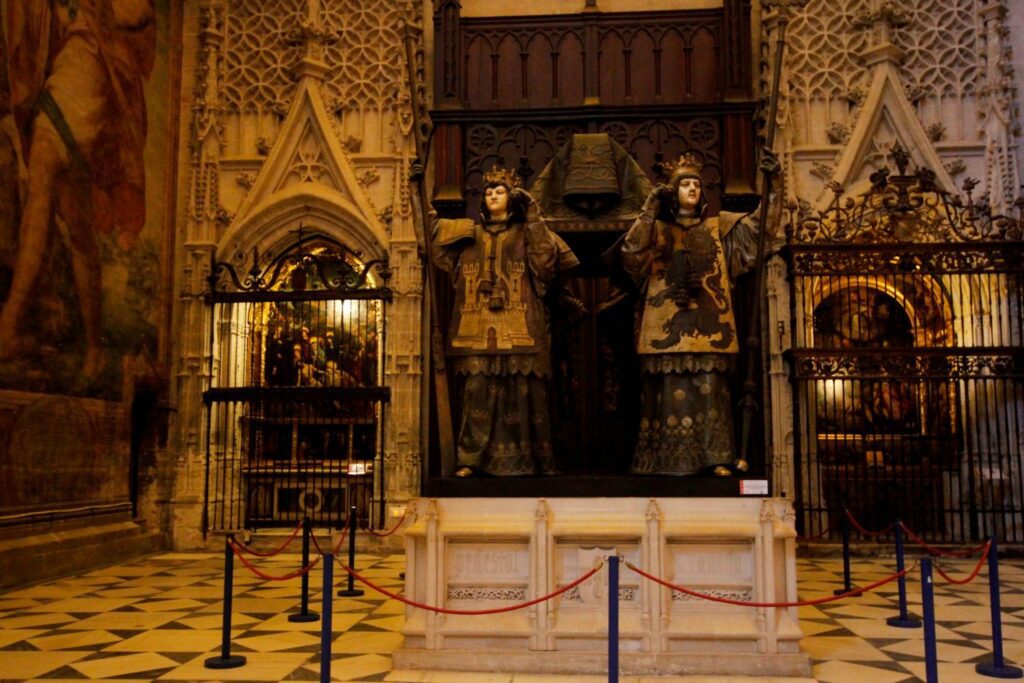A team of researchers that has spent years testing remains to determine the final resting place of Christopher Columbus say the explorer’s remains are in a cathedral in Seville, Spain.
Not much is known about the origins and finalities of Christopher Columbus, who sailed the ocean blue in 1492, landing in what became known as Hispaniola and leaving a trail of slavery and genocide in his wake. The explorer is generally believed to have been born in Genoa, Italy, but his genetic background is something of an enigma—was he Italian, or Basque, or Catalan, or Portuguese? He definitely wasn’t American, I can tell you that much.
Now, a team of scientists in Spain say that an incomplete set of remains in Seville’s cathedral are that of the 15th-century explorer. The team DNA-tested samples of the remains in the tomb as well as DNA from Columbus’ brother Diego and his son, Fernando.
“Today, thanks to new technology, the previous partial theory that the remains in Seville are those of Christopher Columbus has been definitively confirmed,” José Antonio Lorente, a forensic researcher at the University of Grenada, told The Guardian.
The team did not immediately publish a scientific paper of their findings accompanying those claims, though they stated they’ll reveal the explorer’s true origins in a TV special shown in Spain on Saturday, when the country commemorates Columbus’ arrival in the Americas. If there’s one thing I can’t stand it’s scientific research that’s packaged into a dramatized TV special—feels like they’re squeezing every bit of publicity they can from their findings instead of focusing on publishing the research—but to each their own.
According to Atlas Obscura, Columbus had a circuitous path even in death. The explorer died in Valladolid, Spain, in 1506, and was then moved to Seville at the order of his brother, Diego. But in 1542—50 years after his career-defining voyage—Columbus was schlepped over to Santo Domingo’s Cathedral of Santa Maria. There, Columbus’ remains rested until 1795, when Spain lost the Dominican Republic and Columbus was brought to Cuba, where he stayed for a century. Only then—a little over a century ago—were Columbus’ remains brought back to Seville. This shell game of human remains didn’t make pinning down the explorer’s final resting place any easier.
But the plot thickens further; in 1877, a lead box was found in the Santo Domingo Cathedral that had written on it, “Illustrious and distinguished male, Christopher Columbus.” Inside the box were bone fragments. Now, that box is buried at a monument in Santo Domingo Este, but may need to be tested as well; as Lorente pointed out to The Guardian, both known sets of bones are incomplete. In other words, they both could belong to the main man himself.
Columbus was an explorer who had an outsized impact on the United States despite never setting foot in the North American mainland. Though Columbus played a role in American mythmaking as the young country sought to distance itself from its British roots, he had nothing to do with the country that now reflects on his legacy.
What’s most important is that we can agree on certain facts. No matter what Christopher Columbus means to you—or doesn’t—he did not “discover” the New World. People were obviously here for millennia before him, and even jewelry from Europe made its way to North America before the European explorer did.
Source link : http://www.bing.com/news/apiclick.aspx?ref=FexRss&aid=&tid=67095aeb7f92440e98d9f58f125e62c1&url=https%3A%2F%2Fgizmodo.com%2Fresearchers-claim-bones-in-spanish-church-belong-to-christopher-columbus-2000511073&c=10385861407140865038&mkt=en-us
Author :
Publish date : 2024-10-11 05:26:00
Copyright for syndicated content belongs to the linked Source.
